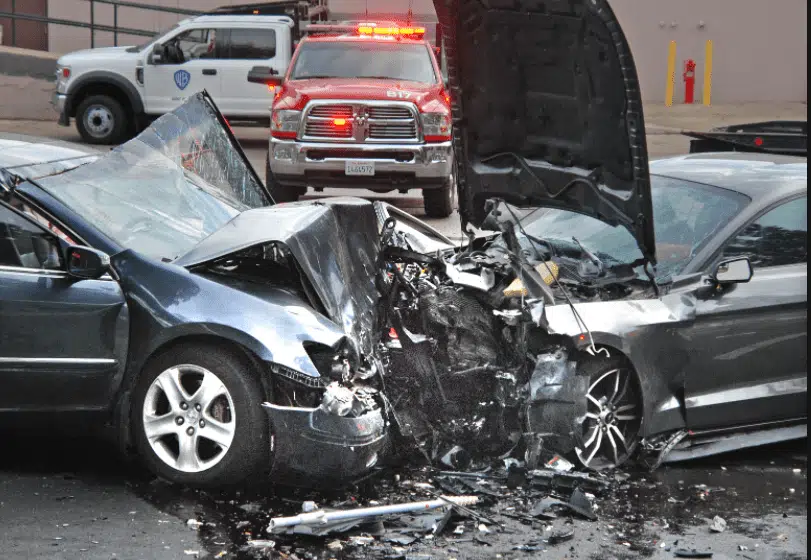A head on collision with another vehicle is one of the most violent and dangerous crashes. This car accident happens when one vehicle slams into another from the opposite direction – head on. These types of serious accidents are relatively rare but make up a large percentage of the fatal car collision injuries reported each year. This is probably because of the high-speed nature of the crashes. When two cars are going 50 MPH hit each other head on, the impact of the crash is at a devastating 100 MPH. This type of speed is too much force for even the safest motor vehicles to sustain without serious or fatal head on collision injuries. According to the NSC, in 2019 nearly 30% of all car accident fatalities were the result of a head on collision.
Most Common Head on Collision Injuries:
While just about any injury is possible in a head on collision, there are some injuries that are more common to a frontal impact crash. Specifically, when a vehicle is travelling forward at a decent rate of speed and hits another car going the opposite direction at a similar speed, all occupants of both cars get thrust forward very violently. This can result in very serious injuries to the head, chest, neck, back and hips, in addition to most internal organs. Here we’ll look at some of the most common injuries suffered in head on collisions.
Head trauma/Concussions
Even if the driver or passenger is wearing a seatbelt and the air bag functions as intended, the person’s head can still strike the steering wheel, windshield, dashboard or other object in the car, causing serious head trauma. Head trauma can cause serious brain injury that may result in death. Even less severe head trauma can cause a serious concussion that affects brain function for days, months, years or permanently. The violent crash of a head on collision can send the driver’s or passenger’s head into the windshield or steering wheel. This can cause a traumatic brain injury that can be minor or severe. You also could get a concussion. A even a mild concussion from a car accident can lead to blurred vision, nausea, dizziness and headaches. A severe concussion can be very serious, causing coma, seizures or even death. It is vitally important to have a prompt medical evaluation after a head injury in a car accident. If the brain hits the inside of the skull during the sudden stop of a head on crash, it can cause bruising and/or bleeding. A concussion can be severe enough to cause very serious, long term brain injury that can leave victims never the same again. Serious brain injuries due to concussion are notoriously hard to diagnose and require the help of an experienced medical team and personal injury attorney.
Broken bones
Many head on accident cause broken arms, hands, legs, pelvis and feet. It is frequent for much of the energy in the head on crash to be transferred to the lower body, leading to many broken bones below the waist. The legs and feet are less well protected than the head and torso in these crashes. Hip injuries are also very common in head on collisions, because the force of the frontal impact can cause the car to crumble in, crushing the legs and putting undue pressure on the hip joints.
Lacerations
The air bags cause can lacerations to the face, arms, hands and chest. Also, bruises or contusions can affect most of the body, including the face, arms and chest. This can be especially dangerous when someone isn’t wearing a seatbelt and has nothing to stop them from flying forward into or through the windshield.
Whiplash
This is wearing the head snaps back and forth on the neck during the crash. Car accident whiplash can cause serious pain and injury that is difficult to see on an X-ray but is very real. It can be a debilitating injury. In a head on or frontal impact collision, the head and neck of drivers and passengers will continue to go forward while the body will mostly stay in the same position, if a seatbelt is being worn. The jerking of the neck and head will continue as they get resistance which often occurs when the chin strikes the chest. This violent action will stretch and strain the muscles and ligaments at the back of the neck and at the base of the head and into the shoulders. Some of the common signs of whiplash after a car accident are serious back, neck and shoulder pain; numbness; weakness, stiffness, dizziness and headaches. But these symptoms may not show up immediately, so it is important to get a medical evaluation right away after the head on collision.
Internal organ damage
When the crash occurs, the force of the seatbelt hitting the body can cause serious trauma to the lungs, stomach, intestines, spleen and liver. These injuries can be fatal if bleeding is severe enough. Such trauma may not be immediately apparent, and it is important for victims to be seen by a medical professional right away. Some of the most common types of injuries include internal injuries to the abdomen and chest due to an airbag or seatbelt. Blunt trauma to the abdomen from the steering wheel or dashboard can cause organ damage and internal bleeding.
Spinal Cord and Back Injuries
Any car accident can cause spinal cord damage, but it’s one of the more common head on collision injuries due to the speed and force of impact. Some examples of injuries to the spine that are common in head on collisions are cracked vertebra, herniated discs, or even damage to the spinal cord. Paralysis can occur due to a spinal cord injury as well as nerve damage that affects the arms, legs or both.
Reducing Head On Collision Injuries:
Here are some guidelines to help you avoid a head on collision in the first place, and to reduce your chances of serious injury if you do find yourself in a head on crash:
- Always drive the speed limit, and slow down at night so that you can hitting things that you cannot see as well during the day. The higher the speed at impact, the bigger the chance that you will suffer a serious injury in a head on crash. While you cannot control the speed of the other driver, you can control the speed of your vehicle by not going over the posted speed limit.
- Never drink and drive or use drugs and drive. Many of these terrible accidents are caused by intoxication.
- Avoid driving at night if you are fatigued. Many head on collision injuries are due to people falling asleep behind the wheel.
- Be certain that you are going the right way on a highway or interstate, especially at night. It is possible to become disoriented in an unfamiliar area or due to fatigue and drive the wrong way.
- Alwaysear your seatbelt. The chances of serious or fatal injury in any car accident are reduced by wearing your seatbelt. It is highly unlikely you will survive a head on collision at high speed without a seatbelt.
- Make sure your vehicle’s safety feature are working. It is especially important to be certain that the airbag will deploy in a frontal impact crash. Check with your dealership to ensure that your airbags are operating normally.
Head on collisions cause some of the most severe, and often fatal injuries. It is very important to be seen by a medical professional right away and to have your case reviewed by an attorney soon. Medical expenses, lost wages and pain and suffering from a head on collision can result in hundreds of thousands or millions of dollars in damages. Few people have the financial resources to handle this burden alone, and a good attorney can help you get a fair head on collision settlement amount that will cover your expenses. lost wages, and pain & suffering.
Luckily, it is possible obtain compensation for your head on collision injuries, including medical costs, lost wages and pain and suffering. Or, if you lose your loved one in such a tragic crash, you can file a wronful death claim and at least get some compensation for death in a car accident. Due to the often catastrophic nature of the injuries suffered in head on collisions, it’s a good idea to discuss the facts of your claim with an experienced car accident lawyer – they’ll be able to help you determine fault, know what to ask for in negotiating your head on collision settlement, and can save you a ton of time and hasle in dealing with insurance companies.

- How Much Is Your Car Accident Settlement Worth?
Find out the maximum compensation you could receive.
- How Much Is My Car Accident Settlement Worth?


